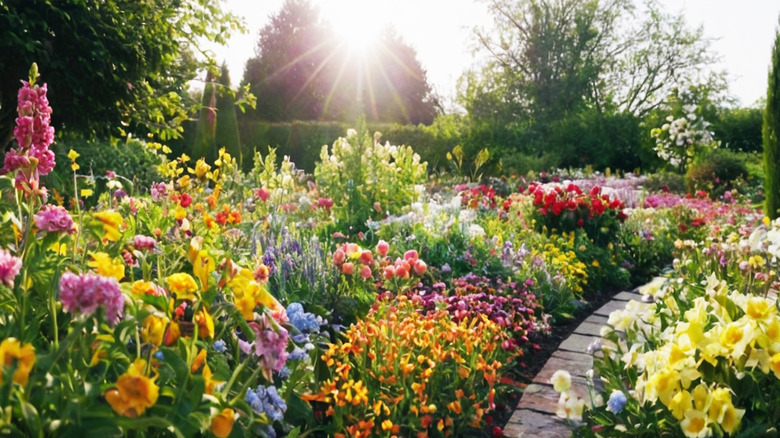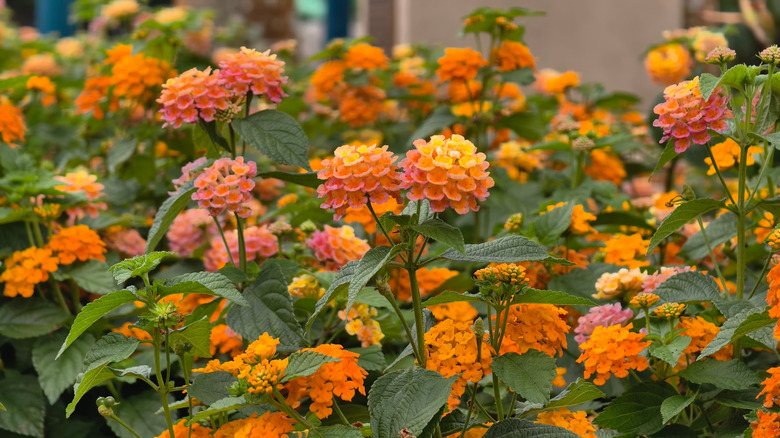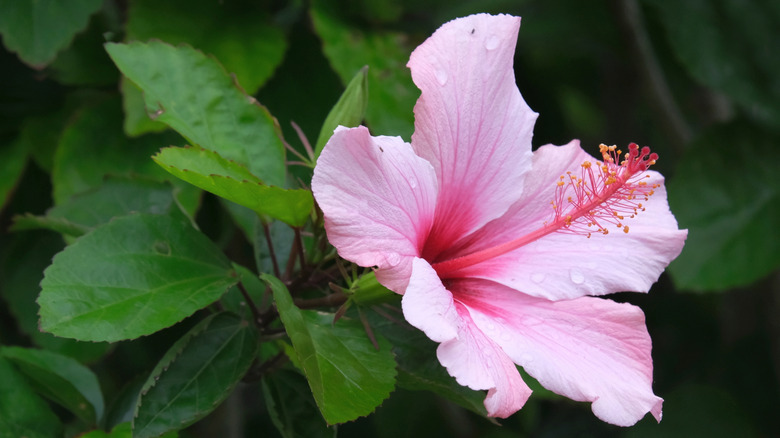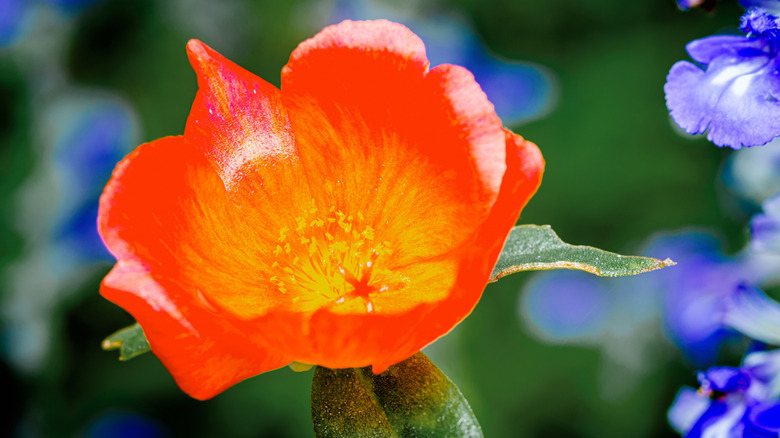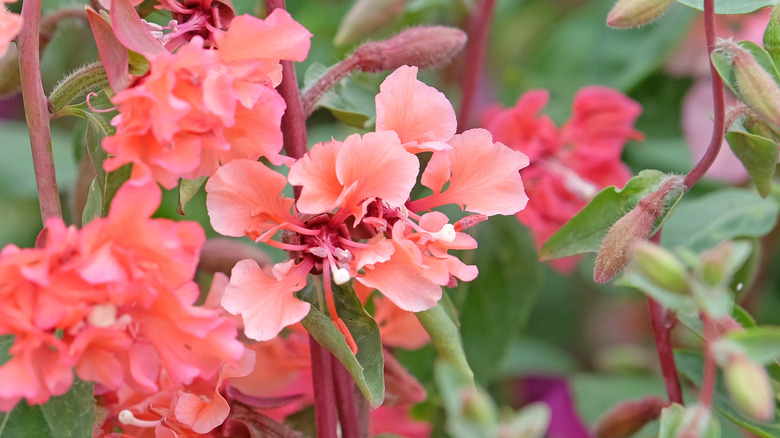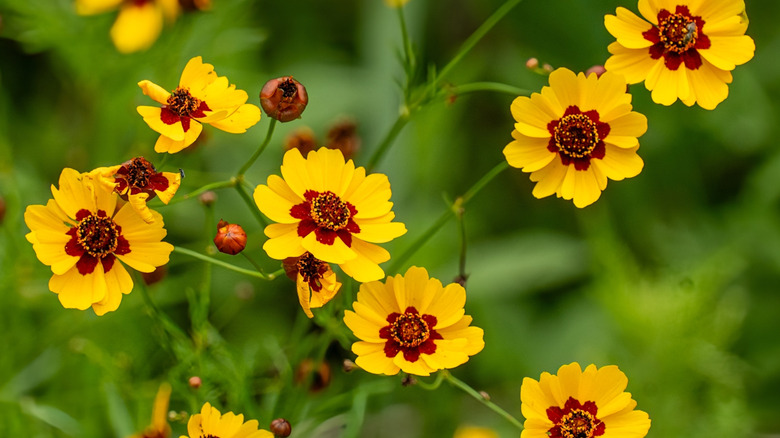15 Fast-Growing Flowers That Can Handle Late Summer Heat And Bloom Into Fall
Keeping a garden vibrant in full sun can be a challenge. Many plants will wilt in the heat, and you might be left feeling resigned to flowerbeds full of dying blooms. But don't despair just yet – there are plenty of gorgeous flowers to consider planting when you have no shade in your yard. From marigolds to zinnias, these fast-growing flowers will thrive in the late summer heat and continue giving you beautiful blooms into the fall.
You can plant these flowers in the middle of a heatwave, and you'll still get flowers within a few weeks. This is because these flowers have adapted to cope with dry conditions — look for plants with small leaves, leaves that are waxy or fleshy or silvery, and hairy leaves. These plants are also adept at holding moisture in their roots, meaning those grown from bulbs or tubers are often extremely sun tolerant. The same is true of plants that put down deep roots that allow them to draw on more nutrients and water from the subsoil. If you look around at some of the native plants growing in the wild in these dry conditions, you'll undoubtedly notice many of these characteristics. But if you're an inexperienced gardener, it can be hard to know where to start. This guide will help point you in the right direction and give you a generous selection of blooms to choose from, which will soon have your garden flourishing again.
Common lantana
Common lantana (Lantana camara) is a bit of a showstopper, producing small tubular flowers in a variety of colors. To successfully grow and take care of lantana plants, you'll need to make sure they have a steady sprinkling of water and direct sunlight for six to eight hours. Do note that it is toxic and is considered invasive in Florida, Alabama, and Georgia as it can take over quickly. Lantana will typically flower around 10 to 14 days after planting and will thrive in USDA zones 7 to 11.
Sunflowers
Sunflowers are native to North America, and the iconic common sunflower (Helianthus annus) is the most recognizable with its giant blooms and impressive height. Sunflowers are the perfect plant for beginner gardeners, being easy to grow and forgiving to mistakes. Grow this low-maintenance plant in full sun and well-draining soil, and you should expect to see flowers sprout within a week, although it could take from 60 to 90 days for them to fully bloom. Sunflowers are generally annuals in zones 2 to 11.
Marigolds
There are many benefits to planting marigolds in your garden, not least their beautiful golden, orange, or yellow blooms. Marigolds (Tagetes) are also attractive to bees and other pollinators, along with being a natural pest deterrent. These reliable growers are annuals in zones 2 to 11 and perennials in zones 9 to 11, sprouting in around four to 14 days and flowering in a couple of months. In fact, the more sun marigolds are exposed to, the more blooms you can expect to see.
Zinnias
Colorful and easy to grow, zinnias (Zinnia elegans) will germinate with a week, and you'll see flowers from around six to eight weeks after planting. Appearing in a variety of colors including pink, red, white, purple, orange, and gold, zinnia flowers are plentiful and vibrant, quickly adding a splash of color. You can also help your zinnias bloom and flourish all season long by fertilizing each month. Happy in full sun and heat, along with well-draining soil, zinnias are perennials in zones 9 to 11 and annuals in zones 2 to 11.
Cosmos
Cosmos (Cosmos bipinnatus) thrives on full sun, producing daisy shaped blooms in a variety of colors including pink, white, and crimson. An aggressive self-seeder, these flowers require little effort and can often return the next year — first flowers will bloom six to eight weeks after planting. Knowing how to care for cosmos is easy – simply provide full direct sunlight and water when they are first planted, along with well-draining soil. Cosmos are perennials in zones 9 to 11. It's worth noting that cosmos might need staking due to their height.
Calendula
Calendula (Calendula officinalis) is an edible flower that will attract bees and pollinators to your garden. Although fans of full sun, calendula plants are also hardy and can be planted earlier in the season than many other fair-weather options. Perennial in zones 9 to 11 and annual in zones 2 to 11, calendula will bloom six to eight weeks after planting. To help keep calendula happy and healthy, it's advisable to cut plants back in the hottest months so that they'll revive in fall. These cheerful gold and yellow flowers add a vibrancy to any garden.
Globe thistles
The globe thistle (Echinops ritro) plant can boost bees in your garden, with its multitude of small blue flowers that make up the thistle head. It's not the most traditional of flowers but that's part of what makes it an attractive addition to a garden. Naturally blooming from mid-summer through to fall, the plant thrives in soil with good drainage and full sun, with at least six or more hours of direct sunlight a day. Growing in zones 2 to 8, this is a fantastic addition to the back of any perennial border thanks to its impressive height.
Catmint
Catmint (Nepeta) is, as the name suggests, particularly attractive to our feline friends. But beyond this, it's also a beautiful plant with pretty silvery gray leaves and blue, purple, or white flowers. This fragrant lavender look-alike can withstand harsher conditions and enjoys well-drained soil in full sun. It will also reward you with a second wave of blooms if you prune it after the first showing has died down. Catmint grows well in zones 3 to 8.
Nasturtiums
If you haven't got green fingers, nasturtiums (Tropaeolum majus) are a flower that even the worst gardeners can handle. Needing little maintenance and growing well in poor soil, nasturtiums are big fans of full sun. Perennial in zones 9 to 11, nasturtiums produce brightly colored golden yellow, orange, pink, red, or white flowers, and bloom in six to eight weeks. Fun fact: Every part of the plant apart from its roots is also edible, with a slight peppery taste.
Hardy hibiscus
There are plenty of tips and tricks to keep your hibiscus plant growing and thriving, but if you want a tough variety that will give you fast growing flowers, hardy hibiscus (Hibiscus hybrid) is the one to go for. However, to speed things up, you might want to buy a plant rather than planting seeds. Hardy hibiscus will grow well in zones 4 to 9 and enjoys full sun and well-drained or moist soil. Although flowers only bloom for one day, one or more flowers will generally open each day over the summer into early fall.
Sweet Alyssum
Sweet Alyssum (Lobularia maritima) is a pretty ground cover plant that will help crowd out invasive weeds. Perennial in zones 9 to 11 and annual in zones 5 to 8, sweet alyssums will sprout in between five and 10 days, producing blooms in six to eight weeks. The plant produces mounds and dense clusters of tiny white or lavender flowers, adding an attractive carpet to any sunny garden. Sweet alyssum is also incredibly tolerant to full sun and will tolerate both drought and dry soil.
Moss rose
Moss rose (Portulaca grandiflora) is a fantastic plant to attract butterflies and hummingbirds, thanks to its mass of yellow, pink, orange, purple, red, and white blooms. Moss rose thrives in dry, rocky soils that many plants would find inhospitable and enjoys full sun for six or more hours a day. Growing in zones 2 to 11, the plant blooms from spring through summer to fall. But it's worth noting that the plant will close up at night and won't open on cloudy days at all.
Clarkia
Clarkia is native to Western USA (apart from C. tenella which is South American). Happily growing as an annual in zones 2 to 11 and perennial in zones 8 to 11, this native plant germinates quickly. You can expect blooms in either gold, pink, purple, or white in around two months, with the flowers closely resembling hollyhock. Clarkia is happy in full sun and well-draining soil but does prefer cooler night-time temperatures.
Plains coreopsis
Plains coreopsis (Coreopsis tinctoria) is a self-seeding flower that will effortlessly cover your backyard with bright yellow flowers complete with a maroon center. This quick sprouting plant will bloom in around six weeks in zones 2 to 11, and loves full sun and rocky or sandy soil. Because of the plant's dislike of wet soil, it's a great choice for those hard to water areas in your garden, needing only very light watering. Plains coreopsis is also another great choice if you're hoping to attract pollinators to your garden.
California poppy
The California poppy (Eschscholzia californica) is, as the name suggests, a beautiful orange flower you'll find across California. But in fact, you can grow this plant across zones 6 to 10, as long as you have plenty of full sun to offer along with well-draining soil. Germinating in a week and flowering in as little as six weeks, California poppies need very little water and are drought tolerant. Deadheading will encourage new blooms, but you can also leave some flowers if you want to encourage self-seeding.
